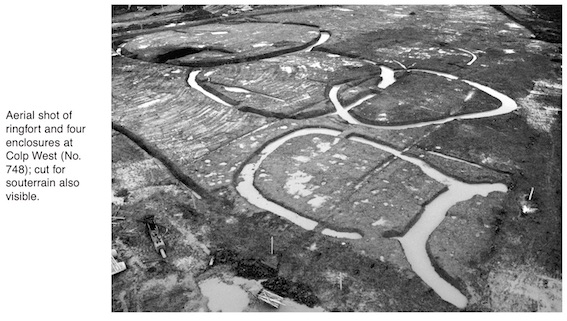County: Meath Site name: COLP WEST
Sites and Monuments Record No.: N/A Licence number: 99E0472
Author: Donald Murphy, Archaeology Consultancy Services Ltd.
Site type: Ringfort - rath, Souterrain, Kiln - corn-drying, Burial and Enclosure
Period/Dating: Multi-period
ITM: E 712649m, N 774393m
Latitude, Longitude (decimal degrees): 53.707060, -6.293720
During monitoring of a housing development at Colp West, Co. Meath, in September 2000, a previously unknown prehistoric and Early Christian settlement, which covered an area of 2 acres, was unearthed. A full archaeological excavation was carried out on this site from October 2000 to February 2001.
The prehistoric phase of settlement at Colp West was defined by a linear ditch, which ran north–south across the site. All the prehistoric features lay to the west of this ditch. It was a probable ritual site, the majority of the features discovered comprising pits and post-holes. Four of these pits yielded numerous sherds of prehistoric pottery, which were, in all likelihood, votive offerings. The majority of other pits yielded cremated bone and a high density of charcoal. The above-mentioned linear ditch was also prehistoric in date, and finds retrieved from this feature include prehistoric pottery, a whetstone fragment and flint. This feature divided the prehistoric pits from the Early Christian ringfort and enclosures.
The principal features uncovered within the Early Christian area of the site consisted of a ringfort, the cut for a souterrain, four enclosures and a large rectangular enclosure. The ringfort had an internal diameter of 24.8m. Numerous features were exposed within the ringfort, including a hearth and some pits. The most impressive feature exposed within the ringfort was the cut for a souterrain. Unfortunately, the stone from the souterrain was removed at some stage during the post-medieval period. Finds retrieved from the souterrain included a highly decorated though fragmentary bone comb. Some of the more impressive finds retrieved from the ringfort include a flint blade, a bronze pin and two corroded blades (from knives).
Four subrectangular/D-shaped enclosures were annexed to the ringfort. These were probably some type of animal enclosures. A palisade trench was visible at the base of two of the enclosure ditches, which would suggest that they were fenced. Finds retrieved from the enclosure ditches include a flint knife and pottery. Two smaller and narrower semicircular enclosures were also exposed within this area. One of these appeared to precede the construction of the larger enclosures, while the other, from which a highly decorated glass bead was retrieved, was constructed at a later date.
Other features exposed within this site include numerous pits, post-holes and linear cuts (which probably functioned as slot-trenches for structures or as drainage). These features all lay in close proximity to the above-mentioned enclosures. Corn-drying kilns also feature predominantly throughout the site. A total of seventeen corn-drying kilns were exposed. These features, although Early Christian in date, were also found in the western section of the site, away from the ringfort and enclosures. These corn-drying kilns generally yielded a high density of charcoal and a small amount of animal and cremated bone. Impressive finds from the kilns include a flint scraper, part of a macehead and pottery. The most impressive find within a kiln was that of a headless burial. The skeleton, of a male, was very badly decayed and was buried in the western base of a kiln. It lay directly on burnt timber and was covered by some very large stones.
A small circular structure was also found in close proximity to another kiln and may have functioned as a small hut.

15 Trinity Street, Drogheda, Co. Louth